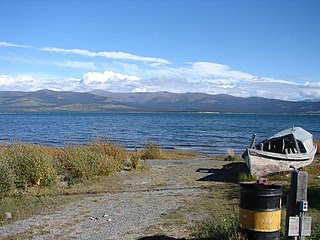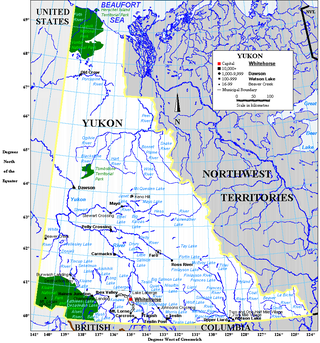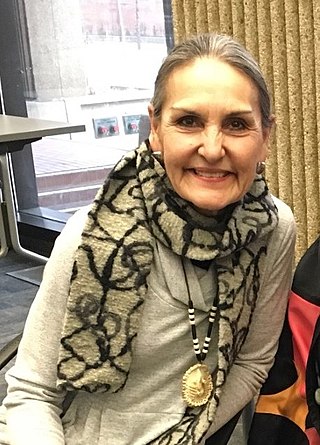
Yukon is the smallest and westernmost of Canada's three territories. It is the third-least populated province or territory in Canada, with a population of 45,148 as of 2023. However, Whitehorse, the territorial capital, is the largest settlement in any of the three territories.

Tutchone is an Athabaskan language spoken by the Northern and Southern Tutchone First Nations in central and southern regions of Yukon Territory, Canada. Tutchone belongs to the Northern Athabaskan linguistic subfamily and has two primary varieties, Southern and Northern. Although they are sometimes considered separate languages, Northern and Southern Tutchone speakers are generally able to understand each other in conversation, albeit with moderate difficulty.
Indigenous music of Canada encompasses a wide variety of musical genres created by Aboriginal Canadians. Before European settlers came to what is now Canada, the region was occupied by many First Nations, including the West Coast Salish and Haida, the centrally located Iroquois, Blackfoot and Huron, the Dene to the North, and the Innu and Mi'kmaq in the East and the Cree in the North. Each of the indigenous communities had their own unique musical traditions. Chanting – singing is widely popular and most use a variety of musical instruments.

Burwash Landing is a small community, at historical mile 1093 on the Alaska Highway, in Yukon, Canada along the southern shore of Kluane Lake.
With the Klondike Gold Rush, a number of folk songs from Yukon became popular, including "Rush to the Klondike", "The Klondike Gold Rush", "I've Got the Klondike Fever" (1898) and "La Chanson du Klondyke".

Yukon is in the northwestern corner of Canada and is bordered by Alaska and the Northwest Territories. The sparsely populated territory abounds with natural scenery, snowmelt lakes and perennial white-capped mountains, including many of Canada's highest mountains. The territory's climate is Arctic in territory north of Old Crow, subarctic in the region, between Whitehorse and Old Crow, and humid continental climate south of Whitehorse and in areas close to the British Columbia border. Most of the territory is boreal forest with tundra being the main vegetation zone only in the extreme north and at high elevations.
The First Nation of Na-Cho Nyäk Dun is a First Nation band government in Yukon, Canada. Its main population centre is in Mayo, Yukon, but many of its members live across Canada and the United States. Members of the First Nation of Na-Cho Nyak Dun claim Gwich'in ancestry, located in north, and Dene ancestry, located in the east, along with their Northern Tutchone ancestry. The Na-cho Nyak Dun are the northernmost representatives of the Northern Tutchone language and culture.
The Selkirk First Nation (Hucha Hudan people) is a First Nation self-government in the Canadian territory, Yukon. Its original population centre was the trading post of Fort Selkirk, Yukon along the Yukon River, but most of its citizens now live in Pelly Crossing, Yukon where the Klondike Highway crosses the Pelly River. The language originally spoken by the Selkirk people was Northern Tutchone. There is a great effort to preserve the language and culture, as can be seen by the popularity of the Selkirk "Keeper of the Songs", Jerry Alfred.

The Northern Tutchone are a First Nations people of the Athabaskan-speaking ethnolinguistic group living mainly in the central Yukon in Canada.
The Caribou Master, variously known as Kanipinikassikueu, Katipenimitak, Papakashtshishk, or Caribou Man is a powerful spirit in traditional Innu religion and mythology, an indigenous people of present-day Canada and Quebec. In the myth, an Innu man goes to live with the caribou. He marries one of the does and is himself transformed into caribou form. He becomes the master of the caribou and the provider of caribou for the Innu people.

The Porcupine caribou(Rangifer tarandus groenlandicus) is a herd or ecotype of barren-ground caribou, the subspecies of the reindeer or caribou found in Alaska, United States, and Yukon and the Northwest Territories, Canada.
The Juno Awards of 1996, representing Canadian music industry achievements of the previous year, were awarded on 10 March 1996 in Hamilton, Ontario at a ceremony in the Copps Coliseum. Anne Murray was the host for the ceremonies, which were broadcast on CBC Television.

The Hän, Han or Hwëch'in / Han Hwech’in are a First Nations people of Canada and an Alaska Native Athabaskan people of the United States; they are part of the Athabaskan-speaking ethnolinguistic group. Their traditional lands centered on a heavily forested area around the Upper Yukon River, Klondike River (Tr'on'Dëk), Bonanza Creek and Sixtymile River and straddling what is now the Alaska-Yukon Territory border. In later times, the Han population became centered in Dawson City, Yukon and Eagle, Alaska.

The history of the Yukon covers the period from the arrival of Paleo-Indians through the Beringia land bridge approximately 20,000 years ago. In the 18th century, Russian explorers began to trade with the First Nations people along the Alaskan coast, and later established trade networks extending into Yukon. By the 19th century, traders from the Hudson's Bay Company were also active in the region. The region was administered as a part of the North-Western Territory until 1870, when the United Kingdom transferred the territory to Canada and it became the North-West Territories.
The Yukon International Storytelling Festival was held every Summer in Whitehorse, Yukon, generally in an outdoor setting. Cofounders of the storytelling festival were storytellers Louise Profeit-Leblanc and Anne Taylor. Profeit-Leblanc, from the Northern Tutchone Nation, was the niece of Angela Sidney, one the Yukon's last Tagish. Sidney had devoted her life to preserving the stories of the Tagish of Southern Yukon, Profeit-Leblanc and Taylor were motivated to found a more local venue for sharing Yukon stories when they realized that Sidney had had to travel in 1984 to the Toronto Festival of Storytelling to disseminate her peoples' stories to a world audience. In 1987 interested parties came together to plan the first Yukon Storytelling Festival in 1988. It later grew beyond the scope of Yukon and Canada to attract storytellers from all over the world with an emphasis on native peoples storytelling and circumpolar countries.
Kim Barlow is a Canadian folk singer and musician.

Louise Profeit-LeBlanc is an Aboriginal storyteller, cultural educator artist, writer, choreographer, and film script writer from the Northern Tutchone Nation, Athabaskan language spoken in northeastern Yukon in Canada. She was raised in Mayo.

The Indigenous peoples of Yukon are ethnic groups who, prior to European contact, occupied the former countries now collectively known as Yukon. While most First Nations in the Canadian territory are a part of the wider Dene Nation, there are Tlingit and Métis nations that blend into the wider spectrum of indigeneity across Canada. Traditionally hunter-gatherers, indigenous peoples and their associated nations retain close connections to the land, the rivers and the seasons of their respective countries or homelands. Their histories are recorded and passed down the generations through oral traditions. European contact and invasion brought many changes to the native cultures of Yukon including land loss and non-traditional governance and education. However, indigenous people in Yukon continue to foster their connections with the land in seasonal wage labour such as fishing and trapping. Today, indigenous groups aim to maintain and develop indigenous languages, traditional or culturally-appropriate forms of education, cultures, spiritualities and indigenous rights.
Mayo was an electoral district which returned an MLA to the Legislative Assembly of the Yukon Territory in Canada. It was created in 1928, at a time when it was one of three districts who elected advisors to the Yukon Territorial Council. The more contemporary, final iteration of the riding was created from an amalgamation of the riding with part of the riding of Klondike. It was abolished in 1992 when it was amalgamated with the riding of Tatchun to form the riding of Mayo-Tatchun.
Chester Knight is a Canadian folk singer-songwriter from Saskatchewan. He is most noted for the 1999 album Falling Down, which won the Juno Award for Best Aboriginal Recording at the Juno Awards of 2000.








